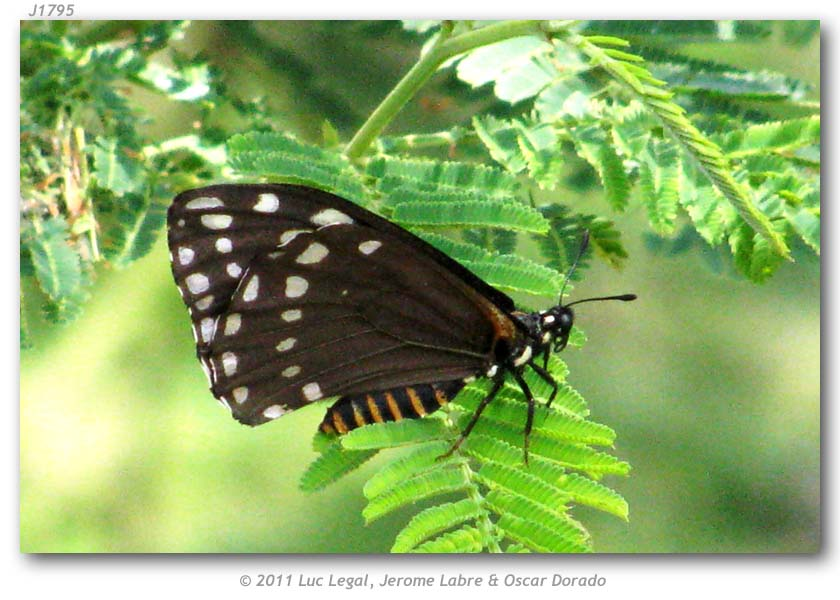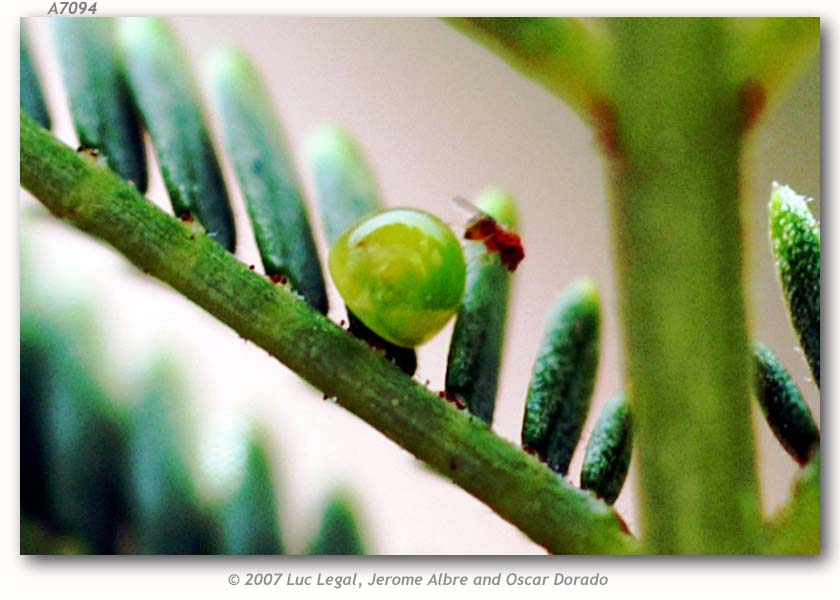This week's butterfly, Baronia brevicornis or the Mexican Comet, is endangered. It can resemble the Monarch, and, like the Monarch, it is a tourist attraction for Mexico. But that's only about half the reason why scientists write about it. Some scientists are absolutely fascinated by evolutionary theory, and, theoretically, they speculate that Baronia ought to be the oldest living butterfly species on Earth. (The structure of its wings resembles the structure of one of the very few butterfly fossils that have been found.) Since these scientists weren't there when Baronia evolved into its present form, or when anything else did, either, this web site will acknowledge that these scientists exist and that they write papers, and then move on. We are interested in the facts about Baronia today.
Dozens of scientific studies of these butterflies are online. Most are written for scientists, which should make them only slightly slower than average reading for The Nephews. Many also require that you either pay to read them, or log in from your school, or else put information about your school and name on the main Internet (not recommended). This post was, however, written by merging my notes on a handful of scientific papers that are available online and adding some of the multitude of fair-use photos. A bilingual document by Ivette Galicia-Mendoza et al. was especially informative.
Baronia commmorates the first specimens having been collected by Oscar Theodor Baron. Brevicornis means "short-horned," and describes its short antennae. Apart from its wings, it could be mistaken for a wasp. It can't bite or sting but it just might have gained some survival benefit from looking as if it could. Photo from Ivette Galicia-Mendoza et al., in https://www.redalyc.org/journal/425/42571635087/html/.
Osbert Salvin's two-page description of "this interesting species" (printed in 1893) has been preserved online at https://archive.org/details/transactionsofen1893roya/page/331/mode/1up?view=theater.
All Baronias don't look alike. There are subspecies, and within subspecies there are different genetic types. However, scientists consider Baronia brevicornis a unique species, part of the swallowtail family but different from all other swallowtail butterflies. (For one thing, it does not actually have swallowtails on its hind wings.) So brevicornis is the only species in the genus Baronia. This makes Baronia brevicornis what some scientists call a "monotypic" species, although it is anything but monomorphic.
Males have spotted wings. They can be generally classified into three color types: light brown with yellow spots, dark brown with yellow spots, and yellow with barely noticeable yellow spots. Brown individuals are much more common than yellow ones.
Dark brown male by Luc Legal. This and other photos from the same source are in the Butterflies of America gallery at .https://www.butterfliesofamerica.com/L/t/Baronia_b_brevicornis_a.htm.
Females have three more distinct color patterns, none of which is easily confused with the males. They an be brown with lots of white spots, blackish with just a few little white spots, or orange with black and white spots. The black or "melanic" type resembles a faded, tailless Black Swallowtail, and the orange resembles the Monarch or Viceroy. The brown type looks more like the males than the other female types do, but is easily recognized as different from the males. The brown type is most common, the orange type most rare. Females are slightly larger than males.
Melanic female from Luc Legal.
There is considerable individual variation within each of these six categories. A melanic female may be faded black all over with only a few little lighter spots at the edges of her wings, or have orange and white spots.
Though brown females are agreed to be the most numerous type in Mexico, the reverse is true in cyberspace. Photos of the more unusual types seem to be seen as more interesting Google has lots of images of brown females, which Wikipedia seems to have chosen as the most representative of the species...all of museum specimens, not living butterflies.
Food plants are thorny bushes, Vachella campechiana, Acacia macrocantha, Acacia pennatula. Caterpillars do not need a forest environment to survive and would, in fact, be at a disadvantage in a fully forested environment, since tall trees would shade out their host plants. They could probably coexist with humans, if people left their host plant alone or protected it from cattle during the one month of the year when the butterflies use it. The form of "habitat degradation" that most threatens them is probably not even domestic plant cultivation, since native bushes can form useful hedges between cultivated fields, but "pesticide" spraying. Mexico has had a history of doing very little to reduce the damage done by reckless use of poison sprays, which, of course, ultimately tend to produce more of the unwanted species.
Acacias positively thrive close to humans, and many humans even like to look at them. A Cambridge University study found no need for humans to avoid Baronia habitat, but an opportunity to help conseve this species by creating more fields where butterflies'' and caterpillars' food plants grow within sight of each other. Any association with a college or university, even if it was thirty years ago, should open the document for you free of charge:
Adults are pollinators and sip nectar from only a few kinds of flowering plants. These butterflies are not long-distnce travellers. They all need a relatively specialized environment, where both butterflies' and caterpillars' food plants grow close together. Having grown up in a place that meets those requirements, they tend to stick to it. Males hang around where a female butterfly is emerging from the pupa. As if they knew that their time is short, males and females seem to agree on the benefit of the female's mating as soon as possible, providing the maximum possible time to distribute her eggs as widely as possible. After a female has mated, males flit on in search of another female, but they tend to stay in the same neighborhood. Butterfly populations do shift from field to field, year to year, to avoid predators but stay close to the coasts of Mexico.
Butterflies recognize one another by smell, so it doesn't matter to this male what the female in the pupal shell is going to look like. She smells fine to him. Photo by Eric Tigrerito.
While females are ready to mate as soon as they can fly, males may have to wait a few days. Since they have only a few days to live, they spend this time behaving, as much as a butterfly can, like immature males. Incapable of doing any real harm to anything, they claim territories and pester other butterflies with nonverbal demands to mate or fight. Since their bodies do not yet contain spermatophores, either of these threats can only be regarded as a joke. Butterflies do sometimes 'play chicken" by flying directly at each other; in a few species, like Monarchs, they may actually collide, but since neither butterfly weighs enough to do any damage, even the collision is more of a game, and an opportunity for courting couples to sniff and touch, than a real threat. Nature has made butterflies completely nonviolent animals. They usually humor the immature males and leave them alone. The actual effect of the males' jackass stage of life may be, some naturalists think, to help females find fresh territory where the next generation of caterpillars may have to avoid fewer stinkbugs. Since the caterpillars are not at all good at avoiding stinkbugs, some researchers think foolish young males may contribute to the species' survival without knowing it.
When ready to fly and/or mate, the newly eclosed female flies up into a tree. The favored male follows, and they can mate either back to back or in a modified hugging position, facing each other around a twig.
Females lay eggs by ones on food plants, spreading them as widely as possible. They live in a dry climate where it's possible for a caterpillar to eat leaves faster than the host plant is able to replace them. Eggs hatch in about five days.
Once hatched, it takes a baby Baronia about a month to eat its way through five skins. These skins are plain, camouflaged as bits of their host plants, with green sides and a brown, black, red, or yellow stripe along the back. Their food plant is not very toxic, nor are they, and many are eaten by other animals before becoming butterflies.
Caterpillars are very vulnerable to predators. Butterfly watchers report that they are more often eaten by stinkbugs or lizards than by birds or by the wasps sometimes released on farms to control nuisance species. Their only defense is not tasting good to predators. Stinkbugs do not consider this a problem. For most lifeforms a stinkbug is fairly easy to see and smell, but the caterpillars seem oblivious. Some of them pull leaves around themselves and tie them together with silk.
Photos by T. Covarrubias-Camarillo suggest that, although the drawn-in leaves may fool some predators, they would not stop a determined stinkbug. Stinkbugs have their place in this world as predators on pests, and local populations of this generally rare butterfly can be dense, but generally sticks and stones can be good for stinkbugs, helping the population evolve tendencies to avoid us. T/ Covarrubias-Camarillo found that predators recognized a caterpillar through a rolled-up acacia leaf, and were able to get at it, but were more likely to look for an unwrapped caterpillar to eat first. Thus the caterpillar's shelter, like its parents' resemblance to wasps and/or less edible butterflies, has a small survival benefit.
After eating all it can eat, the caterpillar pupates on the ground for a few days or several months, depending on the weather. During a rainy summer one local population was observed to produce a new generation every six to eight weeks, though the May-June generation was much larger than the subsequent generations in the year. In drier conditions another local population was observed to have only one generation per year, with butterflies and caterpillars active at the same time, the caterpillars then pupating for ten to eleven months.
The butterflies may fly for as long as three weeks, but it seems likely that most survive less than one week. Despite their resemblances to inedible species, females don't seem to live longer than males; in the Galicia-Mendoza study, their average adult life span seemed a little shorter than the males', possibly because laying eggs creates a moment of disadvantage when the female is easier for a bird or lizard to grab.













No comments:
Post a Comment